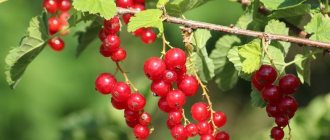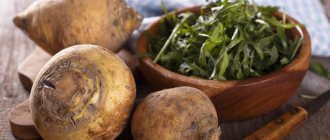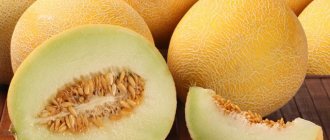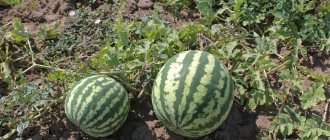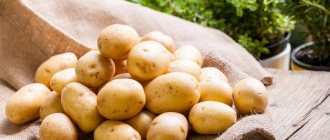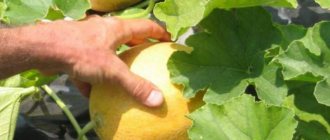Gone are the days when melon was considered an exclusively southern crop. Today, the heat-loving beauty feels great in dacha beds even in Siberia and the Urals. Of course, growing southerners in the northern regions is associated with certain difficulties, but perhaps the most difficult thing is to determine the time of harvest. How do you know if a melon is ripe or is it too early to pick it? A few useful recommendations from experienced gardeners will help you not to miss this important point.
How long does it take for a melon to ripen?
The ripening period of this heat-loving crop lasts from 45 to 100 days.
What determines the rate of aging?
The ripening period of melon depends on the climate, varietal characteristics and growing conditions.
In the Krasnodar Territory, melon can ripen right in the field in mid-July, but in Siberia they begin to enjoy the aromatic product grown indoors only in August.
In hot summers, ripeness may occur a week earlier than the date indicated in the instructions. But if the spring was cold and the summer was cool and rainy, then the crop will take longer to ripen or will deteriorate.
But even in an ideal climate for these fruits, the period of ripeness largely depends on the growing technology (irrigation regime, fertilization, formation and rationing, etc.).
Features of melon ripening
Fruit development occurs in two stages. Initially, the ovary is formed and its growth begins, then the fruit ripens, which continues until harvesting. During the growth period, fruits undergo an intense oxidative process and accumulation of nutrients.
During the growth period, an intense oxidative process occurs in fruits
The ripening period is characterized by a weakening of oxidative processes and an increase in anaerobic processes. At this time, a large amount of ethylene accumulates in the fruits, and without its presence they will not ripen at all. When overripe, the proportion of ethylene decreases sharply.
The content of pectin in melon is also important, which depends on its type, variety and growing conditions. If the proportion of pectin is low (this is typical for early varieties), then the fruits are poorly stored and transported. With an average amount of pectin, melons do not last long, but are transported well. And with a pectin content of more than 10%, melons are well stored and can be transported.
Tip #1. In order for melons to have a beautiful shape, color and ripen well, you will need to turn them over in the beds from time to time. Thus, they are evenly illuminated by the sun and acquire a more regular shape.
When do melons ripen?
When growing melon on their plot, gardeners know approximately how long it takes for the fruit of this plant to ripen. However, the exact ripening time depends on many factors.
Variety
The variety of melon varieties allows you to choose the right one for any region. They are:
- early ripening - ripen in July;
- mid-season – ready to eat in August;
- late-ripening - harvested in September.
Region
In the southern regions, melons grow well in the fields, and the early varieties begin to be harvested there already in mid-summer.
In the middle zone, melons ripen later. Mostly early-ripening and not too large-fruited varieties are planted here.
The further north you go, the less weight the fruit will have, and the less sweetness they will have . After all, this melon crop needs a lot of sun and warmth to acquire a rich taste and aroma.
When growing melons in cold regions, it is important to fulfill three conditions:
- Protect from late frosts in the spring and properly form the plant.
- Limit the number of fruits set (so that one melon grows on one vine).
- Carry out repeated feedings to accelerate growth (every 7-10 days).
Growing in a greenhouse
Seedlings are transplanted into greenhouses in late April - early May. The harvest ripens in 2-3 months, depending on the variety and microclimate. By providing suitable conditions in the greenhouse and making an effort, you can get juicy and aromatic fruits even in Siberia.
Open ground
In temperate climates, seedlings are planted in open ground at the end of May - the first ten days of June, when there is no threat of frost. In this case, the harvest often has to be harvested unripe in August and left to ripen at home.
In the south, melon is harvested from fields and gardens when fully ripe from July to September (depending on the varieties planted).
Storage
Now that we have figured out how to determine the ripeness of a melon and harvested it, it’s time to figure out how to properly and competently preserve the fruits and all their taste and beneficial properties. Who wouldn’t want to enjoy juicy summer pulp filled with sun and memories of summer in the middle of winter?
First you need to find out which melons can be stored and which ones should not be stored. When harvesting, we carefully select those fruits that have no signs of damage, disease, rotting, etc., the melons should be as smooth and even as possible. Also, do not forget that early ripening varieties are stored worse and for less time. And for long-term storage, melons collected in mid-September are best suited.
Do not forget to prepare in advance a dark and dry room, with a fairly low temperature and also low air humidity. For storage you will need shelves or rails under the ceiling. When preparing the room, do not forget that during storage the fruits should not touch each other.
To prevent rot from forming, the fruits are stored in a mixture of sand, sawdust or clean cloth. It is necessary to regularly sort through the melons, inspect and remove at least a little bit of rot in order to protect the rest of the harvest. We also advise you not to store these fruits next to other crops, vegetables or fruits, since then the melons will lose their smell. If you have already cut the body of the melon, you can store it for no more than seven days and only in the refrigerator, but the cut version will only have a real taste for a couple of days. However, you can try freezing and then the taste will remain for several more weeks.
And back to the topic of storage, the best way is to hang the melons from the ceiling so that they do not touch each other and do not stick to their sides. Before storing, do not forget to thoroughly wash and dry the melons, then place each fruit in a separate net or fabric bag and hang it from the ceiling in the prepared room. Don't forget to check the fruits from time to time and enjoy the ripe sunny gifts of your garden.
How to tell if a melon is ripe
In one bed, melon fruits of the same variety can ripen at different times. That’s why it’s so important to be able to determine their ripeness.
First, calculate the approximate ripening time (according to the instructions on the bag of seeds), then visually observe the development of the fruits in the beds.
Methods and criteria for determining maturity
How to tell the ripeness of a melon? Pay attention to these signs:
- Characteristic fragrant aroma . Ripe vegetables have a distinct honey, pear or vanilla smell. Unripe specimens have no aroma. And overripe melon pulp does not smell very pleasant.
- Appearance. The peel should be elastic and have a uniform color characteristic of a particular variety. When inspecting, make sure that the fruit has no mechanical damage, multi-colored spots or rotten areas.
- When pressed, the peel of a ripe fruit springs slightly (there is no dent on the surface).
- Tapping sound. If you tap the sides and hear a dull sound, then the melon is ripe. An unripe one will have a ringing sound.
- The fruit is easily separated from the stalk, which dries out by the time it ripens.
Classification by degree of maturity
To understand how to determine the ripeness of a melon, it is necessary to consider some nuances. A culture has phases of biological and technical maturation. The first (biological or physiological) is determined by the cessation of growth of fruits and the stems themselves. At this stage, the plant enters the dormant stage and can produce seeds for subsequent sowing.
Important! In the room where melons are stored in winter, the temperature should be within 0...+3°C and the relative humidity at 80
–
85%.
Only under such conditions will the fruits retain their taste. Technical or yield maturity in many fruit crops occurs earlier than physiological. Harvest means that the product is ready for harvesting, transportation and storage. However, this culture refers to those whose biological and technical maturation occurs almost simultaneously. That's why you can't go wrong when you start harvesting.
The ripeness of one melon may differ from another. This is due to the fact that the plant does not ripen evenly, even if all the fruits grow in the same bed. This happens, for example, with tomatoes or cucumbers.
How long a melon ripens depends on the variety. This must be taken into account when choosing and planting a plant. Indeed, in case of late harvesting of fruits that are already ripe, the product will be unsuitable for transportation. And early harvesting will not allow the fruits to acquire the desired sweetness and aroma.
According to the degree of ripeness, melons can be:
- Non-commodity. In agriculture, such fruits are given to livestock as feed. They are unsightly and may be cracked or dented.
- Technical. The degree of maturity is determined by the variety. There are early or late ripening species. At this stage of maturity, the Cucurbitaceae family is suitable for technical purposes such as pickling or canning.
- Green mature. Harvested before biological ripeness. They are allowed to lie down and ripen indoors.
Advice from experienced summer residents
In order for melons to grow into a beautiful shape and ripen faster, the formed green fruits are turned over in the beds from time to time. With such uniform sunlight, the peel acquires a uniform color on all sides.
Sugar content and juiciness will be imparted to melons by timely feeding. Half of the norm of nitrogen fertilizers is applied at sowing, and the second part - when the fourth true leaf appears.
It is optimal to pick ripe melon fruits in the morning, before the heat starts, or late in the evening.
Winter or mid-late varieties are harvested at the stage of technical ripeness. During storage, they gradually ripen, while their taste and aroma improve significantly.
When growing melons for sale, you should not collect them at the stage of biological ripeness, because they will quickly deteriorate during transportation. For transportation, slightly unripe specimens are selected, while preserving the stalk.
Early varieties are picked fully ripe and immediately eaten - they are stored for no more than a week.
External signs of ripeness
Even melons of the same variety grown in the same neighborhood may not ripen at the same time, so when choosing a ripe fruit, be guided by the following signs:
- Aroma . A ripe melon emits a magical fragrance, and in the area of the stalk the smell is most pronounced. Green melons do not smell, but the aroma of fermented fruit indicates that the fruit is overripe.
- Appearance . A dense network of wrinkles on the surface of the peel is a sure sign that the melon is ripe. If the mesh is only slightly “drawn” or only covers half of the fruit, then you need to wait before harvesting. Some melons do not form a net, in this case you should pay attention to the color of the fruit - it must correspond to the variety.
- Sound . Lightly pat your beauty's steep sides. A ripe melon will respond with a dull sound, an unripe one with a ringing sound.
- Elasticity . When pressed, the skin of a ripe melon should spring back slightly without being pressed.
- Separation from the whip . Towards the end of ripening, the melon stalk dries out, and the ripe fruit is easily removed.
Tip : to speed up ripening, it is recommended to regularly turn the melons in the garden during cultivation to ensure even sun exposure.
Growing melon in open ground
Planting melon in open ground is carried out after weak plants have been discarded, and good ones have 5-7 true leaves. When the frosts have finally passed (at the end of May - beginning of June), make holes in the prepared bed, pour in water and very carefully plant the seedlings together with a lump of earth from a pot at a distance of 70x70 cm.
You shouldn’t deepen it too much - the lump should rise slightly (1-2 cm) above the surface of the bed. Form a watering hole around the coma, water again (0.5 liters per plant) and sprinkle the holes with dry soil.
At first, the melon needs to be in the shade, so cover the beds with plants with white spunbond, stretching it over arches.
Spunbond is an environmentally friendly, lightweight and durable material with excellent light and breathability. With its help, they create an excellent microclimate; it protects plants from wind and scorching sun.
After 20-22 days, when the melon blooms, the spunbond can be removed (to allow insects to pollinate the plants), covering the beds with it only in cool weather and at night. After removing the cover, water the bed and loosen it, and carefully lay the shoots on the surface.
If the melon blooms but there are still no ovaries, carry out hand pollination. To do this, in the morning in dry weather, carefully cut off the “male” flowers (flowers on a regular peduncle), tear off the petals and touch the middle of each to the “female” flowers (there is a noticeable thickening at the base of the flower) 3-5 times, repeat the procedure after a few hours. If there are no “male” flowers, similar cucumber flowers can be used for pollination.
When 3-5 fruits appear, remove the remaining ovaries and pinch the melons (tops of the plant). Also trim off the side shoots that do not bear fruit. You need to water the melon very moderately, as it can hardly tolerate high humidity. Watering with warm water into the irrigation hole is done after the soil has dried, so that water does not get on the stems and leaves.
To prevent the fruits from rotting from contact with the ground, place planks under the ovaries.
This watering can be combined with root feeding: for 10 liters of water, take 20 g of ammonium nitrate and pour 2 liters of solution into each well.
HOW TO SELECT THE CORRECT VARIETIES TO GROW BETTER QUALITY MELONS.
We told you how to grow melon in your garden, but it is also important to choose the right varieties.
We offer you the best hybrids and varieties of melon from our collection:
These are the most delicious, unpretentious, early varieties and hybrids resistant to cold, disease and weather anomalies. Take your pick – there are melons for every taste!
Now you know how to grow a melon, so feel free to plant it and get tasty and healthy fruits.
In August 2022, a Cantaloupe melon weighing 29.89 kg entered the Guinness Book of Records. The US record holder looked appetizing, although her coloring was uneven.
In the vastness of Russia, fruits do not reach such sizes, but with some effort, you can grow sweet and tasty fruits here too. In this article we will find out when melons ripen and what parameters influence this.
Preparing a bed for melons
Start preparing the soil in the fall: dig up shallowly (20-25 cm), add rotted manure or humus at the rate of 3-4 kg per 1 sq.m (if you will also add humus or rotted manure to the holes when planting seedlings, then the dosage should be reduced by 2 times) and leave the bed until spring.
In March, repeat the procedure, but this time apply phosphorus-potassium fertilizer (in the proportions indicated on the package). Then, just before planting, dig up again and apply nitrogen fertilizer (according to the instructions).
Fresh manure is not suitable for applying under a melon, because... affects the taste of the fruit and leads to a decrease in the disease resistance of the plant.
The best predecessors for melon: early cabbage, onions, table root vegetables. Under them, you can add limestone material (ground limestone, burnt slaked lime, dolomite flour, chalk) in advance in the fall. Liming the soil immediately before planting melons is done only in exceptional cases and no later than 2 weeks before planting seedlings in the ground. Approximate norms for different soils are presented in Table 1.
| Norms for applying lime materials under melon | |||||
| The soil | Optimal pH value | Lime rate (g per 1 sq.m.) | |||
| Soil acidity less than 4.5 | Soil acidity 4.6-5 | Soil acidity 5.1-5.5 | Soil acidity 5.6-6 | ||
| Light loamy | 6,5 | 800-1200 | 600-800 | 400-600 | 300-500 |
| Sandy loam and sandy | 6 | 500-600 | 400-500 | 300-400 | 100-300 |
The most common varieties
“Sybarite’s Dream” is an early variety for a short summer (50-55 days). The fruits are small (weighing about 400 g), elongated, with a striped green color. The pulp is white, crispy, with a honey taste and aroma. Does not get sick, bears fruit abundantly, until frost.
"Titovka" refers to ultra-early maturing (55-70 days). Fruits with thin skin, yellow, orange or yellow-orange. The pulp is white, dense with a fragrant aroma. Well kept. Suitable for the south and middle zone.
“Cinderella” is an early ripening variety (60 days), suitable for short summer conditions. The fruits are round, yellow, covered with a convex mesh. The pulp is white, juicy, and has a rich aroma. The variety is resistant to temperature changes, diseases and pests, but does not tolerate storage and transportation well.
“Collective Farmer” is mid-season (79-95 days). The fruits are spherical, orange-yellow, covered with a mesh. The pulp is sweet, aromatic, light yellow. It fits well. Suitable for the south and middle zone.
"Pineapple" - mid-early (70-80 days). The fruits are rounded and elongated, have a rich orange color, closer to a brown tint. The pulp is light pink, juicy with a sugary taste and a light pineapple aroma. Suitable for the south and middle zone.
FROM THE HISTORY OF MELOON
Ancient Egypt and northern India are considered the birthplace of melon. Judging by ancient frescoes dating back to the 3rd century BC, it was the most delicious fruit that was served to the table of the ancient pharaohs and high nobility.
Here it was widely cultivated in melon fields by ancient tribes. More than a dozen different varieties of melon grew on the African continent. Most of them were distinguished by their hard bark, from which they made dishes for dry sweets, since the delicate melon aroma of its bark complemented their unusual taste.
Melon came to Europe in the Middle Ages and immediately spread widely throughout Western Europe. At first it was grown in the gardens of the highest nobility and served only on major holidays, but then it quietly migrated to the gardens of ordinary people.
Melon seeds were very expensive, but there were so many of them in each fruit that some, thrown into the trash, were simply given to the peasants for free.
The first samples of various cultivated varieties of melon were brought to our country in the late twenties of the last century. It was with them that breeding work began on the creation of domestic varieties of this wonderful crop in several scientific institutions located in different regions of the country.
By the beginning of the 50s, melon was grown in all southern regions and regions of the Soviet Union. At the end of the 90s, work began on creating frost-resistant melon varieties for the northern regions of Russia.
USEFUL PROPERTIES OF MELONS
Regular consumption of melon helps stabilize sugar, uric acid, prothrombin and bilirubin in the blood. Helps strengthen blood vessels, normalizes the functioning of the gastrointestinal tract, liver and pancreas.
With a high content of vitamins and nutrients, melon has a very low calorie content, so obese people must include it in their diet.
Stored fruits, unfortunately, lose most of their beneficial properties due to their high content of nitrates and nitrites obtained from chemical fertilizers, which are used in large quantities in the industrial production of vegetables and fruits.
Below we will tell you how to grow melon in your own garden using only natural organic food.
How to grow melon seedlings at home?
The answer to the question of when to plant melon seedlings depends on the weather conditions in your area. In the middle zone, planting melon seedlings is usually carried out in mid-April, 25-30 days before planting in open ground.
Prepare the soil for melon seedlings. To do this, take peat, turf soil and humus in equal parts and add 1 tbsp. superphosphate, 1 tbsp. ash, 1 tsp. urea and 1 tsp. potassium sulfate, mix thoroughly.
Melon does not tolerate picking well, so you need to sow seeds for seedlings in pots with a diameter of 10 cm. Moisten the soil mixture and plant 2-3 seeds in each pot to a depth of 2-3 cm, sprinkle with a layer of sand 1-2 cm thick.
At a temperature of 25-28°C (minimum 18-20°C, at lower temperatures the seedlings will not grow) seedlings will appear on the 3-5th day
A week after germination, leave one, the most developed plant in each pot and reduce the temperature to 20-25°C. When the third true leaf appears, pinch the seedling above it (remove the growing point) so that the plant grows in width rather than height. Do not over-moisten the soil, water it with warm water at the root.
Foliar fertilize seedlings with complex chlorine-free fertilizer twice: 10 days after germination and a week before planting. 7-10 days before planting, you can begin hardening the seedlings, increasing the ventilation time or moving the pots to the balcony.
Melon is too soft - reasons
When you press on the nose of the melon, opposite the stalk, you feel a slight bend under your finger. If excessive softness of the fruit is felt in this place, this means that the melon is either overripe or has been stored for a long time in not the best conditions. There is a practice of scratching the skin of the melon, but this destroys its integrity.
To buy a melon that is not only tasty, but also healthy, you need to make sure of its quality. Externally, the fruit should not be damaged. It should have a pleasant, tasty aroma. If you press on the melon in the place opposite the stalk, it should bend slightly. If the melon is too soft, it means it is overripe or has been stored for too long. Some people advise scratching the skin, but it is better not to do this, as the integrity of the surface is compromised.
What kind of skin does a ripe melon have?
The peel of a melon is its kind of advertisement, but it should be correctly deciphered by the following signs: when you press it with your finger, you should feel the springiness of the peel; If when you press it, it seems too soft to you and there is still a fingerprint left, then you have in your hands an overripe melon that belongs in the trash heap or compost pit.
Ripening time depending on variety
Melon ripening time lasts from 55 to 85 days.
Each variety has its own time limit, but there are common factors that influence this indicator:
- Climatic conditions of the landing site. Melon culture is widespread in more than 40 countries of the world. In hot regions, the ripening period is shorter than in cold regions, despite the identity of the variety.
- Variety is the main condition. Selection has given different varieties to representatives of pumpkin plants, which, although they adapt to different climatic conditions, ripen differently.
- Agricultural technology. Compliance with growing rules affects not only the taste or presentation, but also when the melons ripen. Over-fertilization, infrequent watering and pests can slow down the process.
Popular varieties and their ripening times:
Sowing melon seeds
Unfavorable predecessors for melon are nightshade and pumpkin crops. If you have to plant a melon after these plants, you must remove their remains before and after harrowing, then loosen and disinfect the soil, for example, spray it with a 5% solution of potassium permanganate.
Experienced gardeners in the middle zone rarely resort to growing melon without seedlings in open ground, because if there are not enough warm days, the fruits simply do not have time to ripen. For sowing in a greenhouse, you can use seeds of ultra-early ripening varieties of melon (ripening period 55-60 days): Altaiskaya, Titovka. The most popular are medium-sized melons of early ripening varieties: Kolkhoznitsa, Skazka, Blondie, etc.
Ultra-early ripening melon varieties
For sowing, select full-bodied large melon seeds for seedlings. Make a 5% solution of table salt (50 g of salt per 1 liter of water) and add melon seeds to it. Stir and remove any seeds that float to the surface. Rinse the remaining ones with running water.
The next important step is etching. To disinfect, dip the seeds in the prepared solution of potassium permanganate (1 g per 1 liter of water) and leave for 20 minutes.
In order to “charge” the seeds with microelements and speed up their germination, dilute 1 tsp in a glass of water. ash and soak the seeds for 12 hours (you can wrap them in cloth for convenience). Then rinse and blot with a napkin.
Melon seeds for sowing for seedlings must be full-bodied and large
Considering the heat-loving nature of melon and the weather conditions in the middle zone, the seeds can be hardened. To do this, wrap them in a damp cloth and place them on the radiator overnight, then put them in the refrigerator and leave them there for about a day. After this, return the seeds to a warm room (15-20°C) for a day. Repeat this procedure 3-5 times.


